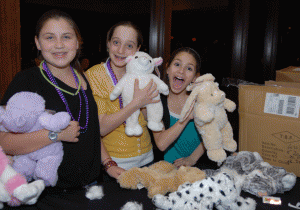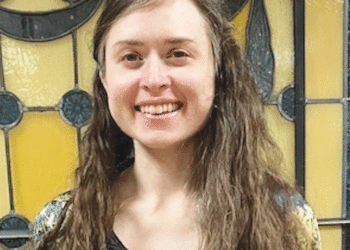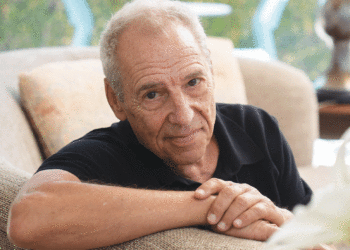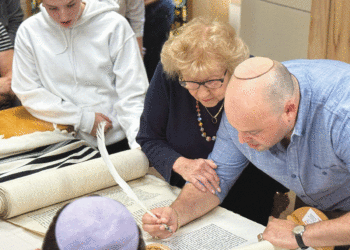Local youth incorporate service projects into their rite of passage celebration
By TAMAR FENTON
In preparation for my eldest son’s Bar Mitzva five years ago, he and I discussed different ways to make the event more meaningful — how to put the “mitzva” into his Bar Mitzva experience.
After investigating several projects that fit his criteria, he decided to send care packages to Jewish soldiers in Iraq and Afghanistan, as well as to “lone soldiers” (those without family) in Israel. He wrote letters to stores and businesses, and received hundreds of pounds of donated items: nonperishable kosher food, socks, CDs, writing pads and decks of playing cards. He supplemented the donated items with purchases using his own money.
He then invited his friends to take part in this mitzva by setting up an assembly line at his party. Each friend could assemble a package of “goodies” and write a letter to a soldier, and feel that they, too, could thank soldiers for their many sacrifices on behalf of their country.
Much of the money my son received as Bar Mitzva gifts went to mailing more than 100 five-pound boxes to military posts halfway around the world.
Sometimes, the Bar or Bat Mitzva is seen as little more than a graduation ceremony representing the end of that young person’s Jewish education — rather than its beginning. However, the idea of incorporating gemilut chasadim (acts of kindness) as a way to make the Bar or Bat Mitzva experience more powerful and enduring has been gaining momentum over the last few years.
Many rabbis recommend that B’nai Mitzva families read the book Putting God on the Guest List, by Rabbi Jeffrey Salkin, as a starting point for discussing how to make this ancient rite of passage more inspirational for their children.
Each year, some teens opt to create a Mitzva Fund through the local federations — the Minneapolis Jewish Federation or the United Jewish Fund and Council of St. Paul. Rather than giving a personal gift or check, guests are invited to make a contribution to the philanthropic fund, from which the young person will contribute to causes and organizations they choose each year. More than 90 of these funds have been established locally.
As more families embrace the potential for continued Jewish connection that the Bar or Bat Mitzva can inspire, it is now common to see kiddush luncheon table displays filled with items to be donated to schools, hospitals and food shelves. Some families have added volunteerism to the Bar or Bat Mitzva preparation in the year preceding the event.
Inspired by naturalist John Muir, Asher Mintzer became interested in environmental causes and decided to designate a portion of his Bar Mitzva gifts to support the North Heron Lake Game Producers Association. In addition to financial contributions to protect the water and natural habitat of Minnesota, Asher participated in a program to reintroduce four young trumpeter swans from the Minnesota Zoo into their new habitat in southwest Minnesota.
Danielle Appleman spent six months making tallitot (prayer shawls) for girls attending a Jewish day school in Cuba so they would be able to wear their own tallit at their Bat Mitzvas. Each tallit took about 20 hours to make, including the time that Danielle spent with Rabbi Avraham Ettedgui of Sharei Chesed Congregation learning to tie the tzitzit (fringes) so that each tallit would be “kosher.” Accompanied by her father, Danielle traveled to Cuba to donate them just before her own Bat Mitzva celebration in October 2008.
Eli Finkelstein involved his neighbors and the guests invited to his Bar Mitzva in his project. He distributed shopping bags to everyone on his block and included a note in his Bar Mitzva invitation explaining that he was collecting food and monetary donations for the Second Harvest Food Bank. After his celebration, Eli loaded more than 225 pounds of food, which he delivered — along with a check for $1,800 — to Second Harvest.
Sophie Stillman, a competitive figure skater from Minnetonka, wanted her simcha to incorporate her love of skating and her sense of justice. Wanting to give other kids the opportunity to experience the same thrill she did when she stepped onto the ice, Sophie used some of the money she received for her Bat Mitzva to purchase 23 pairs of new ice skates to donate to the North Commons Park and Recreation Center.
And when Jonah Tapper was preparing for his Bar Mitzva, he recalled the support and care he received when he was hospitalized for several weeks as a child. Jonah’s party included workstations where all of the guests assembled soft fleece blankets and stuffed animals for children at Gillette Hospital in St. Paul. At the end of the evening, 100 blankets and 150 stuffed animals were delivered to the hospital.
Becoming a Bar or Bat Mitzva marks the transition from childhood to becoming a responsible member of the Jewish community. How fitting that the first decision that these young people made upon accepting that responsibility was to do a mitzva.
Â
Â
How to get started
Here are some suggestions on incorporating a mitzva project into your simcha:
• Discuss with your child issues and needs about which he or she is passionate, or present several local or global concerns that your child can research.
• Consider what your child is good at and if that can be a starting point for the project.
• Think creatively about how you might be able to address that issue in terms of action, volunteerism, donations, creating awareness and involving others in the mitzva.
• Partner with a local agency that is working on that issue.
• Identify adults that you know who may be able to help with your mitzva project.
• Determine if there are ways to get other kids involved in your project before, after or during your celebration.
There are several resources on the Web, and local agencies such as Jewish Family and Children’s Service of Minneapolis or Jewish Family Service of St. Paul may be able to provide good ideas as well. In addition, the National Council of Jewish Women, Greater Minneapolis Section, will launch its Stuff for Kids program on May 4, which will use donated money and items to create backpacks for homeless and highly mobile children in Minneapolis. For information, visit: www.ncjwmpls.org or call the NCJW office at 952-922-7900.
— Tamar Fenton




















